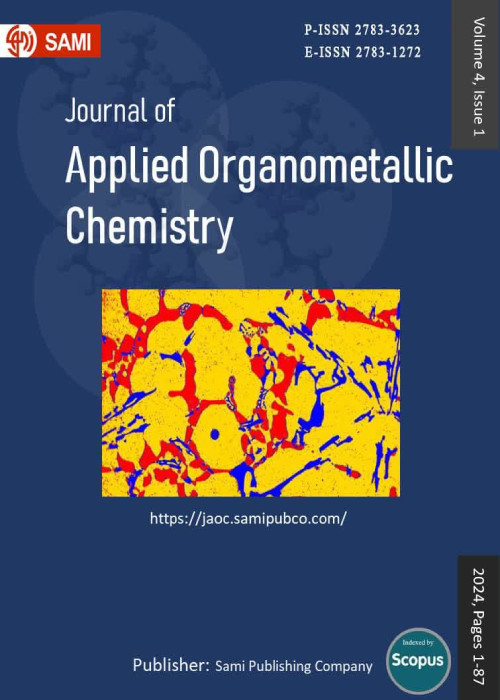فهرست مطالب
Journal of Applied Organometallic Chemistry
Volume:2 Issue: 2, May 2022
- تاریخ انتشار: 1401/02/11
- تعداد عناوین: 6
-
-
Pages 54-65The computational investigation of change in the infrared vibrational frequency of some Schiff base-transition metal complexes relative to that observed in the Schiff base ligand was performed using density functional theory (DFT) based on the hybrid functional of three parameters Becke-3-Lee-Yang-Parr (B3LYP) with 6-31G(d,p) basis set. All the calculations were carried out using the Gaussian 09 program package, and the data obtained from the frontier molecular orbitals of the optimized ligand and its complexes showed that the complexes were less stable and more reactive than the ligand. The infrared vibrational frequencies of the Schiff base functional group had lower stretching vibrations in the complexes than the ligand, with the appearance of new vibrational frequencies therein not observed in the spectrum of the ligand. These observations can be used to confirm bond formation between a Schiff base and a transition metal in chemical synthesis.Keywords: Schiff base, Infrared frequency, Transition Metal, Density functional theory
-
ZnCl2-SiO2 Supported Synthesis and Characterization of Novel 2-Phenylquinazolin-4(3H)-one DerivativePages 66-73
The present report describes a convenient novel synthetic to method synthesize quinazolin-4(3H)-ones from simple and readily available 2-aminobenzamide and benzaldehyde in the presence of catalyst ZnCl2-SiO2 giving corresponding 2-phenylquinazolin-4(3H)-one derivatives 3A-3F. These newly synthesized products have been characterized by FT-IR, 1H-NMR, and mass spectroscopic techniques. These newly synthesized products have been characterized by FT-IR, 1H-NMR, and mass spectroscopic techniques.
Keywords: ZnCl2-SiO2, 2-phenylquinazolin-4(3H)-one, aminobenzamide -
Pages 74-80Polyhydroquinolines are crucial compounds with a very wide range of biological functions such as vasodilation, anti-atherosclerosis, liver protection, and anti-diabetic. It is also used in the preparation of drugs such as nifedipine, nicardipine and Lacidipine. The common method of synthesis of polyhydroquinolines is one-step condensation reaction of Dimedone, aldehydes with ethyl acetate and ammonia in the presence of various catalysts such as MCM-41, molecular iodine, bread yeast, etc. Most of these methods have disadvantages such as low gain, high reaction temperature, long time. In this research, cerium oxide / zinc oxide nanoparticles have been reported as a very effective and economical catalyst for the four-component and one-pot reactions of polyhydroquinolines using the reaction of Dimedone, Aryl halide, ethyl acetoacetate and ammonium acetate.Keywords: Polyhydroquinolines, Cerium oxide, Zinc oxide, multi component reaction, one-pot condensation reaction
-
Pages 81-88The Transition metal complexes of Cu (II), Ni (II), Fe (III) Co (II) Mn (II) and Cd(II) with DHA Schiff base ligand derived from 2-aminopyridine were synthesized, characterized by elemental analysis, (FTIR, UV-VIS, 1HNMR and XRD ) spectroscopic techniques, Thermal and Magnetic study. The antimicrobial (Anti-bacterial and Ant-fungal) activity of ligand and metal complexes have been screened in vitro against 1) Baccilus Subtilis 2) Staphyallococcus aureus 3) Aspergilus niger and 4) Candida albicans. The composition and structure of synthesized Schiff base ligand and all metal complexes confirmed by elemental analysis, (FTIR, 1HNMR, UV-VIS and Magnetic study) spectroscopic techniques, Stability of complexes confirmed by thermal study. The synthesized Schiff base ligand and all metal complexes are found to be biologically active. Co (II) and Cu (II) complexes exhibit maximum and Fe (III) complex exhibits minimum zone of inhibition.Keywords: Dehydroacetic acid, Schiff bases, Metal complexes, Antimicrobial activity
-
Pages 89-100The ZnO-Polyaniline nanocomposites with ratios of 9:1, 8:2, and 7:2 were successfully synthesized using a grinding method in ethyl alcohol. The XRD, TEM, and SEM characterizations are used for the analysis of the nanocomposites. The entire three nanocomposites were degraded by methyl orange in the presence of visible light. We get the best results for ZnO-Polyaniline (7:3) catalyst. About 82 % degradation of methyl orange was observed below visible light within 140 minutes.Keywords: Photodegradation, ZnO-Polyaniline nanocomposite, Methyl Orange, Visible light, Room temperature, XRD, SEM
-
Pages 101-108Synthesis of widespread types of nanoparticles including metal oxides by plant extract is considered as alternative chemical synthesis methods. ZnO nanoparticles are synthesized by a biological process using flaxseeds (Linum usitatissimum L.) extract. The biosynthesized ZnO NPs were characterized by XRD and SEM, EDX, DLS spectroscopy. According to the SEM images, the synthesized nanoparticles are spherical shape with agglomeration and based on XRD, average crystallite size of the ZnO NPs is 15.45 nm.Keywords: ZnO nanoparticles, Flaxseed, aqueous extract


